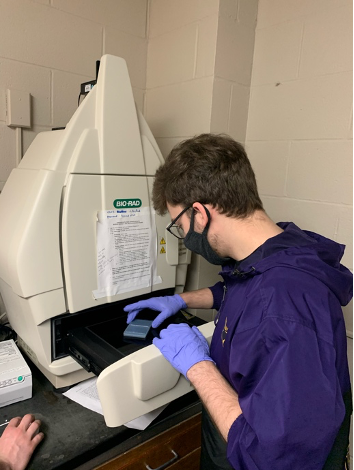By D’Aaliyah Johnson & Matthew Trenne
April 13, 2021
Introduction:
During the past few weeks since our last blog post — February 27, 2021 — we have continued to work with our miRNA’s, Hsa-Mir-4297 and Hsa-Mir-1207 3p, in the Cancer and Immunity Stream with Dr. Land. Since then, we have encountered some setbacks, but there have been so many improvements that outweighed our hardships. The process of redoing specific labs and figuring out what went wrong has shown us how science can be unpredictable and gave us the strength to work through it as a team.
Specific Content:
In our eighth week in the lab, we ended up amplifying our MiRNA and running them in a gel to determine if our MiRNAs had indeed amplified. Our expected banding was at 300bp, and our MiRNAs did indeed show banding at that size; however, so did our controls leading us to believe that we cross-contaminated the samples at some point.
The following week we ran the same experiment as before, trying to amplify our MiRNAs following the same process, and this week our gel came out perfect. We saw banding exactly where it should have been, around 300bp, and both of our controls were negative. In the lab, we also worked on bacterial transformation; our goal was to introduce a new plasmid into the E. coli DNA that we were working with. After working through the lab, we ended up streaking bacterial plates with our E. coli samples; both of our active E. coli plates had good growth and were what we were expecting. Our control plate that did not have the plasmid also did what was expected and did not grow on the plate.

The following week our goal was to isolate and amplify both our E. coli sample and finish the amplification on our MiRNA. Both procedures followed very similar protocols, and we were able to do both at the same time. After the prodigal was completed and we thought our samples were amplified, we then took the samples to the nano dropper to determine if the ratio of everything was what was expected. On both of our E. coli samples and both of our MiRNA samples, our numbers looked terrific.
The previous week we worked with an E. coli sample that was a little more forgiving; this week, we worked with a different E. coli strain that is a little harder to work with. We changed to this new E. coli because it will duplicate what we want it to faster and better. We worked on inserting our specific MiRNAs into the E. coli to create copies of our MiRNA.
That brings us to this week; we are working with our new E. coli and amplified miRNA. We are taking the E. coli that was cultured on plates last week and introducing our MiRNA, and running a gel on them to see if we can determine where banding is going to be.
Reflection:
We have learned a lot so far during lab. It was brought to our attention early on that labs will not always go as expected. We have had to encounter the long hours of hard work and dedication to get the results we wanted, and now we have begun to experience loads of success in the lab. Protocols were repeated, some more than others, but in the end, we were able to achieve fantastic data and acquire new skills that we would not have gotten elsewhere.
As of right now, we have gotten great bands on electrophoresis gels, good numbers on our nano drops, and plenty of colonies of bacteria. Within the next three weeks, we will hopefully have the appropriate results to pause for the summer. Once we come back in the fall, we will be ready to pipet miRNAs once again!


